| Columns Retired Columns & Blogs |
Bluesound PowerNode streaming integrated amplifier Measurements
Sidebar 3: Measurements
I tested the Bluesound Powernode with my Audio Precision SYS2722 system, then repeated some tests with the magazine's more recent APx500 system. I connected the Powernode to my network and controlled it with the Bluesound app on my iPad mini. (When I first connected the amplifier, it updated its BluOS firmware to v3.16.7.) I used the app's "Customize Inputs" screen to disable "A/V mode" on the inputs with which I was going to do the testing, as this is said to be best for audio-only sources.
As the amplifier has a class-D output stage, I inserted an Audio Precision auxiliary AUX-0025 passive low-pass filter between the test load and the analyzers. This filter eliminates RF noise that could drive their input circuitry into slew-rate limiting. I used it for all the loudspeaker output tests other than frequency response. After two hours of operation, the temperature of the amplifier chassis was only slightly warmer than room temperature, at 93.9°F (34.4°C) on the bottom panel, a few degrees lower in temperature on the top panel.
I looked first at the Bluesound's performance via its single-ended analog inputs. The input impedance was a relatively low 7k ohms at 20Hz, dropping slightly to 6.4k ohms at 20kHz. The maximum gain at the loudspeaker outputs was 34dB with the tone controls bypassed; it was 6dB lower with the controls active but set to 0dB. At the headphone output the gain was –3.15dB, ie, an input of 1V resulted in an output of 696mV. The Powernode preserved absolute polarity from both the speaker and headphone outputs.
The Bluesound amplifier's output impedance at the headphone output was a very low 1 ohm from 20Hz to 20kHz. The output impedance at the loudspeaker terminals was 0.1 ohm at 20Hz and 1kHz, rising very slightly to 0.12 ohm at 20kHz. (These figures include the series impedance of 6' of spaced-pair loudspeaker cable.) The modulation of the amplifier's frequency response, due to the Ohm's law interaction between this source impedance and the impedance of my standard simulated loudspeaker, was therefore negligible, at ±0.1dB (fig.1, gray trace). The response into resistive loads (fig.1, blue, red, cyan, magenta, and green traces) and from the headphone output rolled off rapidly above 20kHz, which suggests that the Powernode digitizes its analog inputs, most probably with a sample rate of 44.1kHz. The rolloff meant that the Bluesound's reproduction of a 10kHz squarewave was a pure sinewave (fig.2). A 1kHz squarewave was reproduced with ringing on its leading edges (fig.3), confirming that there is analog/digital conversion.
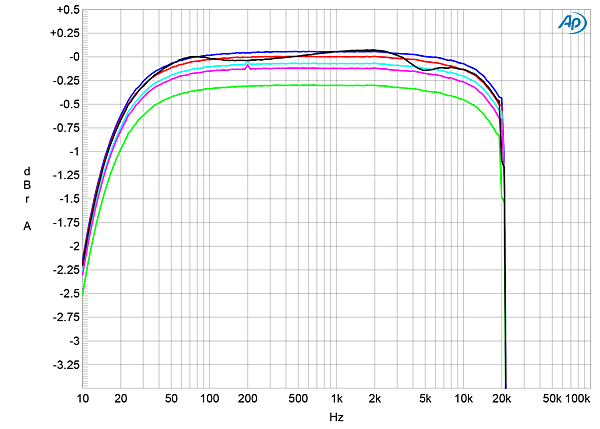
Fig.1 Bluesound PowerNode, volume control set to maximum, frequency response at 2.83V into: simulated loudspeaker load (gray), 8 ohms (left channel blue, right red) 4 ohms (left cyan, right magenta), (left green) (0.5dB/vertical div.).
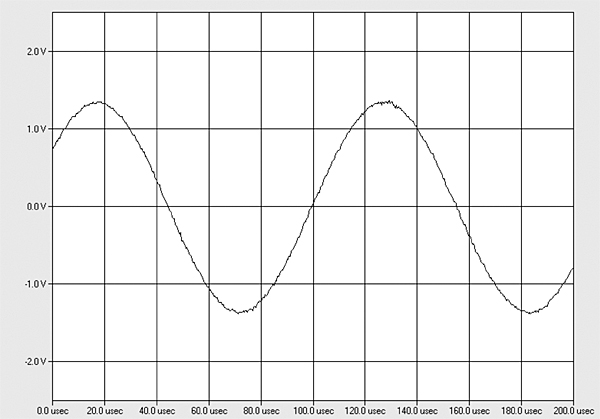
Fig.2 Bluesound PowerNode, small-signal 10kHz squarewave into 8 ohms.
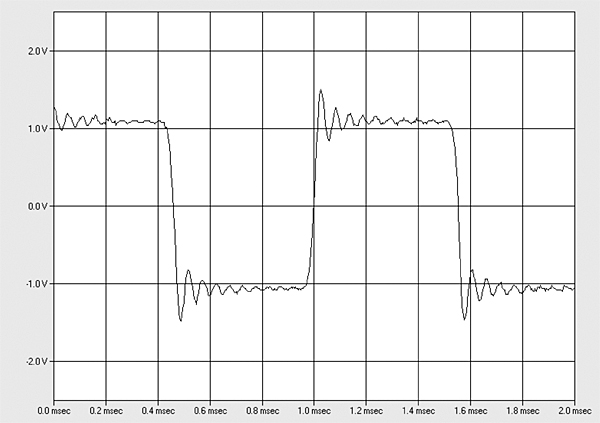
Fig.3 Bluesound PowerNode, small-signal 1kHz squarewave into 8 ohms.
The bass and treble controls offered a maximum boost and cut of ±6dB (fig.4), which explains the 6dB reduction in maximum gain with them active. (If the gain hadn't been reduced, operating the controls at their maximum settings would have resulted in waveform clipping.)
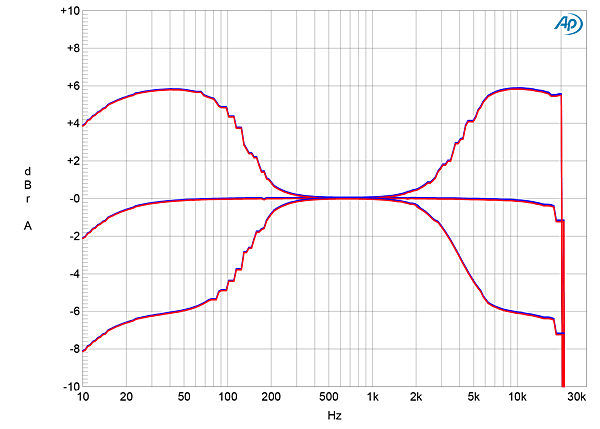
Fig.4 Bluesound PowerNode, frequency response at 2.83V into 8 ohms with treble and bass controls set to their maximum and minimum and switched out of circuit (left channel blue, right red, 2dB/vertical div.).
Channel separation was okay, at >60dB in both directions below 1.5kHz, but 40dB at the top of the audioband. Without the auxiliary low-pass filter, there was 220mV of ultrasonic noise present at the loudspeaker outputs. With the filter, the Bluesound's unweighted, wideband signal/ noise ratio, taken with the unbalanced inputs shorted to ground but the volume control set to its maximum, was good, at 64.4dB ref. 2.83V into 8 ohms (average of both channels). This ratio improved slightly to 65dB when the measurement bandwidth was restricted to the audioband, and to 74.5dB when A-weighted. The background noise included spuriae at 60Hz and its odd-order harmonics (fig.5). The blue and red traces in this graph were taken with the volume control set to the maximum. Reducing the volume by 20dB lowered the levels of the 60Hz component by the same 20dB, and the higher-order harmonics disappeared beneath the random noisefloor.
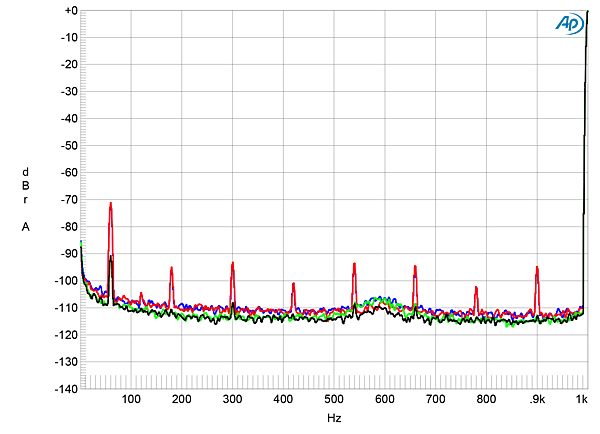
Fig.5 Bluesound PowerNode, spectrum of 1kHz sinewave, DC–1kHz, at 1W into 8 ohms, volume control set to maximum (left channel blue, right red) and to –20dB (left green, right gray; linear frequency scale).
With both channels driven, the Powernode met its specified continuous maximum power into 8 ohms of 80Wpc (19.05dBW) at 1% THD+noise (fig.6). However, very little more power was available into 4 ohms, the Bluesound clipping at 84Wpc into that load (16.23dBW, fig.7). I didn't test clipping power into 2 ohms as the amplifier isn't specified into that load. The distortion lies below the noisefloor at low powers, so I examined how the THD+N varied with frequency at 12.65V, which is equivalent to 20W into 8 ohms and 40W into 4 ohms. Fig.8 shows that the distortion at low frequencies is the same into both impedances, at 0.02%–0.03%. It does rise at higher frequencies, with some peculiar frequency-dependent behavior in the top octave.

Fig.6 Bluesound PowerNode, distortion (%) vs 1kHz continuous output power into 8 ohms.
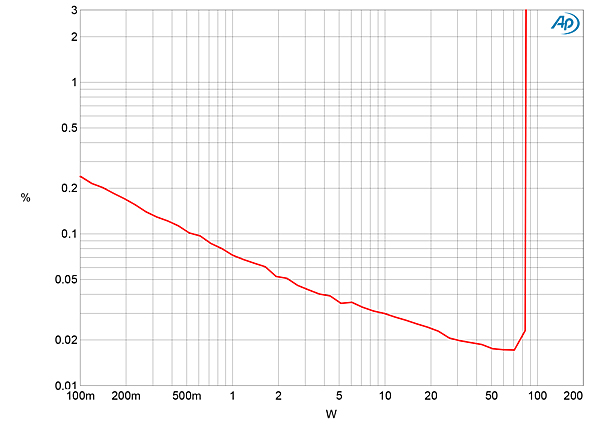
Fig.7 Bluesound PowerNode, distortion (%) vs 1kHz continuous output power into 4 ohms.
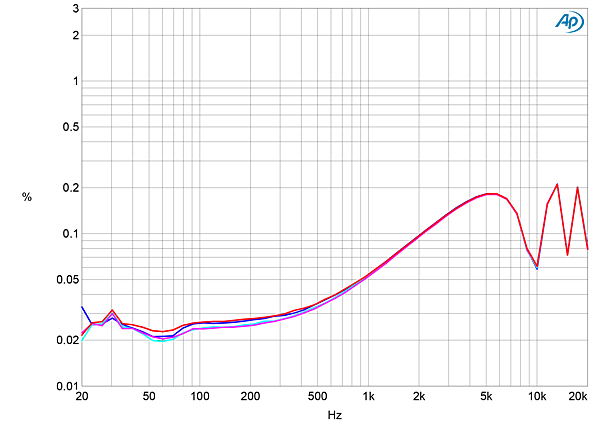
Fig.8 Bluesound PowerNode, THD+N (%) vs frequency at 12.65V into: 8 ohms (left channel blue, right red), 4 ohms (left green, right gray).
The distortion was predominantly low-order harmonics (fig.9), which was confirmed by the spectrum of the Powernode's output when it drove a 50Hz tone at 20Wpc into 8 ohms (fig.10). The subjectively benign second and third harmonics are the highest in level, each lying at –80dB (0.01%). The second harmonic rose a little at the same voltage into 4 ohms (not shown), though the third dropped slightly. When the Bluesound amplifier drove an equal mix of 19 and 20kHz tones at 20W peak into 8 ohms, all the intermodulation products lay at or below –80dB (0.01%) in both channels (fig.11). The digitizing results in aliased images of the tone at 24.1kHz and 25.1kHz, confirming that the A/D converter operates at 44.1kHz.
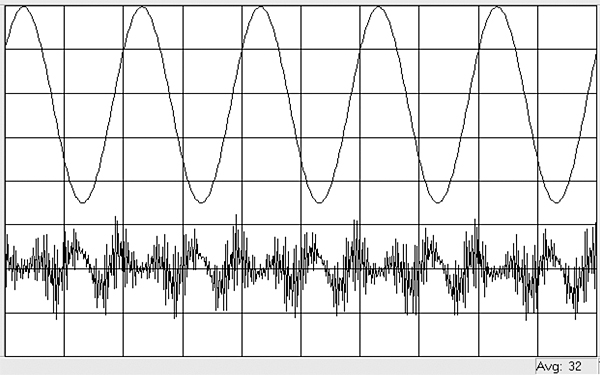
Fig.9 Bluesound PowerNode, 1kHz waveform at 20W into 8 ohms, 0.053% THD+N (top); distortion and noise waveform with fundamental notched out (bottom, not to scale).
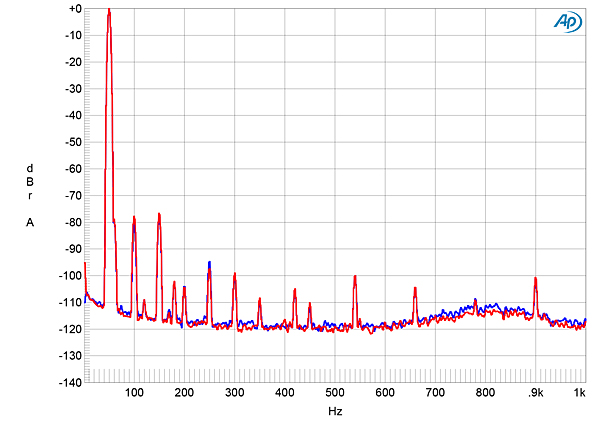
Fig.10 Bluesound PowerNode, spectrum of 50Hz sinewave, DC–1kHz, at 20W into 8 ohms (left channel blue, right red; linear frequency scale).
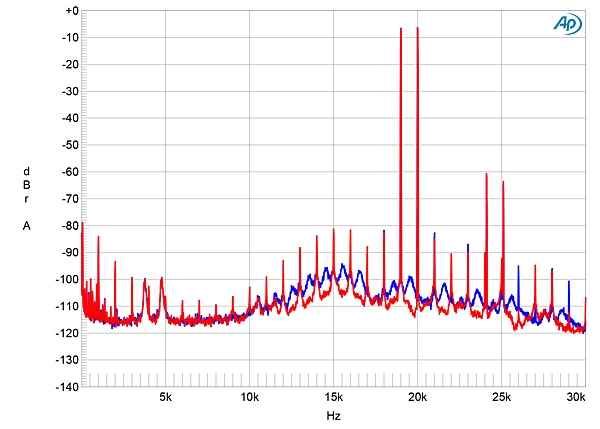
Fig.11 Bluesound PowerNode, HF intermodulation spectrum, DC–30kHz, 19+20kHz at 20W peak into 8 ohms (left channel blue, right red; linear frequency scale).
I examined the Bluesound Powernode's D/A performance primarily using its TosLink S/PDIF input, repeating some of the tests with WAV files on a USB drive plugged into the rear-panel USB port. I initially performed the measurements at the headphone output, then repeated some tests at the loudspeaker output.
The Bluesound Powernode's optical input locked to data sampled up to 192kHz, and absolute polarity was preserved with this input and with WAV files on the USB stick. With the volume control set to its maximum, 1kHz digital data at –20dBFS resulted in a level at the headphone output of 144mV and at the loudspeaker outputs of 10.29V. The latter is 7.9dB below the Bluesound's clipping voltage into 8 ohms. It appears, therefore, that the digital inputs have around 12dB of excess gain. I therefore continued the testing with the volume control set to –12dB to avoid driving the output stage into clipping with high-level digital signals.
The impulse response with 44.1kHz data (fig.12) indicates that the reconstruction filter is a minimum-phase type, with all the ringing following the single sample at 0dBFS. With 44.1kHz-sampled white noise (fig.13, red and magenta traces), the Powernode's response rolled off sharply above 20kHz, reaching full stop-band suppression at 24kHz, just above half the sample rate (vertical green line). The aliased image at 25kHz of a full-scale tone at 19.1kHz (blue and cyan traces) is suppressed by 56dB, and the distortion harmonics of the 19.1kHz tone all lie at or below –70dB. Some odd, low-level noisefloor modulation is present in the spectrum of the 19.1kHz tone, which was taken at the loudspeaker outputs. This behavior was absent when I repeated the measurement at the headphone output, but the tone's third harmonic had risen to –40dB (1%).
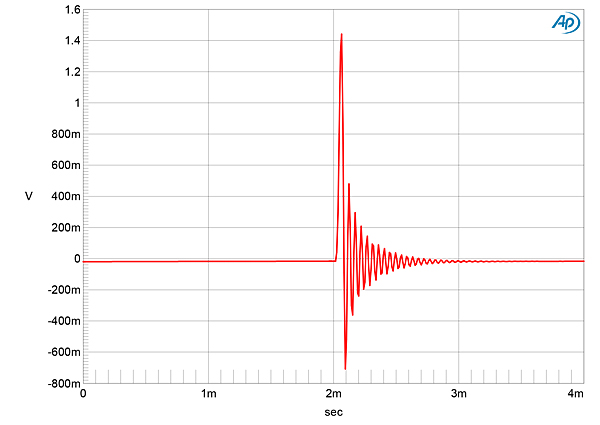
Fig.12 Bluesound PowerNode, Toslink input, impulse response (one sample at 0dBFS, 44.1kHz sampling, 4ms time window).
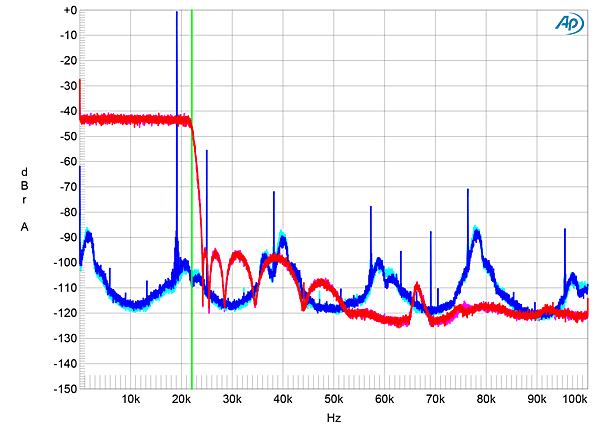
Fig.13 Bluesound PowerNode, Toslink input, wideband spectrum of white noise at –4dBFS (left channel red, right magenta) and 19.1kHz tone at 0dBFS (left blue, right cyan), with data sampled at 44.1kHz (20dB/vertical div.).
The digital-input frequency response with 44.1kHz data was flat in the audioband with then a sharp rolloff just below half the sample rate (fig.14, green and gray traces). The levels of the two channels were perfectly matched. The high-frequency rolloff doesn't seem as steep with 96kHz data (cyan, magenta) and 192kHz data (blue, red), but this is due to the presence of aliased images.
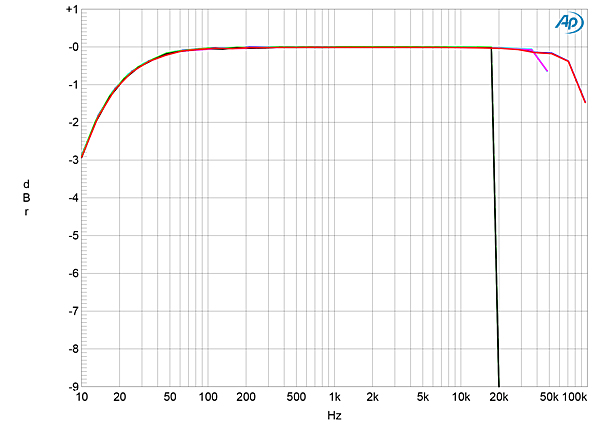
Fig.14 Bluesound PowerNode, Toslink input, frequency response at –12dBFS into 100k ohms with data sampled at: 44.1kHz (left channel green, right gray), 96kHz (left channel cyan, right magenta), 192kHz (left blue, right red) (1dB/vertical div.).
When I increased the bit depth from 16 to 24 with a dithered 1kHz tone at –90dBFS (fig.15), the noisefloor dropped by 10dB, which implies that the Powernode offers close to 18 bits' worth of resolution. With undithered data representing a tone at exactly –90.31dBFS (fig.16), the three DC voltage levels described by the data were obscured by high-frequency noise. Intermodulation distortion via the Bluesound's digital inputs, measured at the loudspeaker outputs (fig.17), was very similar to the behavior with analog input signals. It was higher at the headphone output, however, the difference product at 1kHz lying at –70dB compared with –84dB.
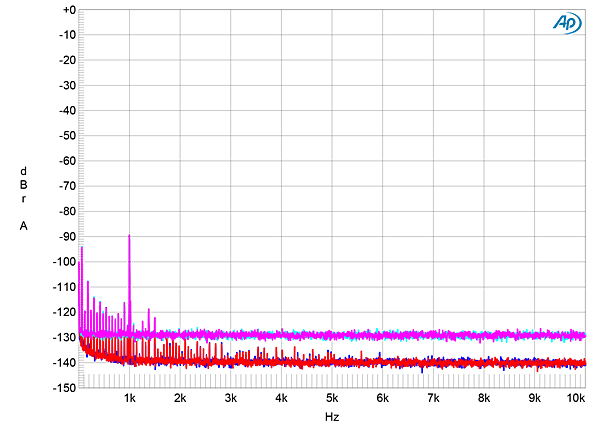
Fig.15 Bluesound PowerNode, Toslink input, spectrum with noise and spuriae of dithered 1kHz tone at –90dBFS with: 16-bit data (left channel cyan, right magenta), 24-bit data (left blue, right red) (20dB/vertical div.).
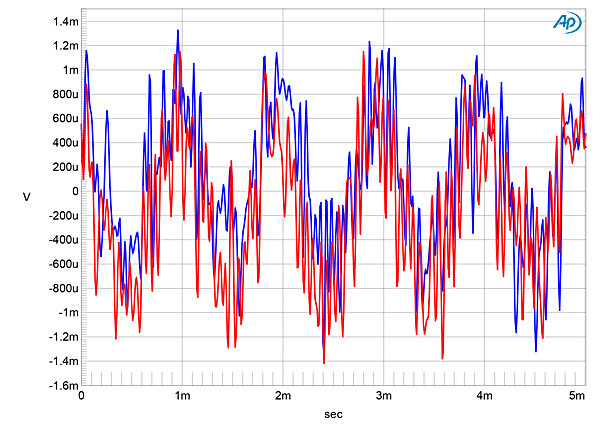
Fig.16 Bluesound PowerNode, Toslink input, waveform of undithered 1kHz sinewave at –90.31dBFS, 16-bit data (left channel blue, right red).
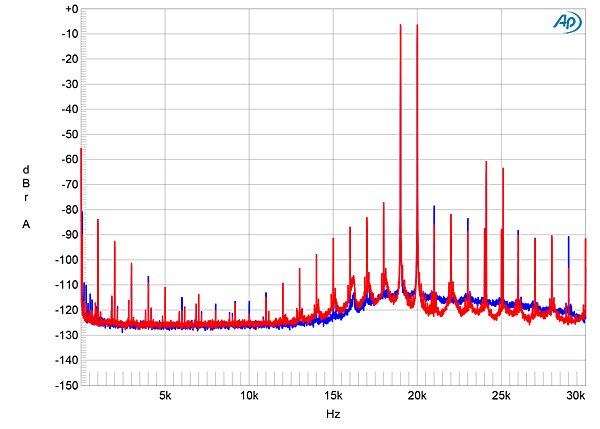
Fig.17 Bluesound PowerNode, Toslink input, HF intermodulation spectrum, DC–30kHz, 19+20kHz at 0dBFS into 100k ohms, 44.1kHz data (left channel blue, right red; linear frequency scale).
I tested the Powernode for its rejection of word-clock jitter via its TosLink and USB inputs. The odd-order harmonics of the 16-bit J-Test signal's LSB-level, low-frequency squarewave were obscured by the random noisefloor with both the loudspeaker outputs and the headphone output. However, the noise sidebands centered at ±1166Hz in the loudspeaker spectrum (fig.18) were absent from the headphone output.
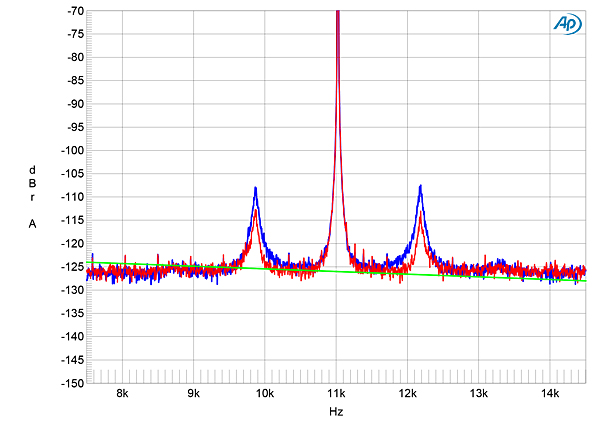
Fig.18 Bluesound PowerNode, Toslink input, high-resolution jitter spectrum of analog output signal, 11.025kHz at –6dBFS, sampled at 44.1kHz with LSB toggled at 229Hz: 16-bit data (left channel blue, right red). Center frequency of trace, 11.025kHz; frequency range, ±3.5kHz.
To some extent the Bluesound Powernode's measured performance is affected by noise contamination from the class-D output stage. Overall, however, it did well on the testbench, especially considering its affordable price.—John Atkinson
- Log in or register to post comments




































